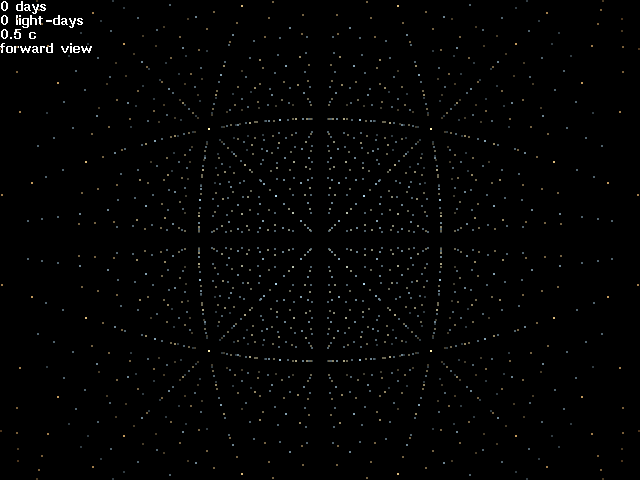What would it be like to travel in a real starship? It's weirder than Star Trek, but not nearly as fast-paced. xrel depicts, as realistically as possible, the appearance of stars as seen from a starship moving at speeds close to the speed of light. The results are surprising, maybe even counterintuitive, but physically accurate to the limits of my knowledge.

Example: Traveling through the Lattice Cluster at 0.5 c
You can run xrel yourself, if you have what it takes -- it should run on most UNIX systems with the standard math library and X window system libraries and display on any X terminal or workstation X display. Just get the source code, and read about how to build it and run it on your system.
Each image is a 640x480 GIF, but don't worry -- most images are fairly small files that won't take long to download (the largest is about 12K and most are around 5K). You can pick images from their descriptions below, or view a page where they're all inlined.
These images were generated with xrel -seed 19660410 -times 0 -size 2 at the indicated velocity, and show the same random starfield.
"Normal" space moving backwards at 0.2 c
"Normal" space moving backwards at 0.5 c
"Normal" space moving backwards at 0.8 c
These were generated with xrel -lattice 5 -times 0 -size 2at the indicated velocity, and show a cubic lattice of stars.
The Lattice Cluster at 0.5 c (shown at the top of this page)
The Lattice Cluster moving backwards at 0.2 c
The Lattice Cluster moving backwards at 0.5 c
The Lattice Cluster moving backwards at 0.8 c
Coming soon: about the physics behind xrel, and how xrel works (including the cheesy approximations).
As a start, here's a brief explanation of how the apparent brightness of stars is measured and why they have the colors they do.
These people have also done relativistic visualization work, with varying focuses and levels of realism.
Wade Lutgen <wade@pacific.mps.ohio-state.edu> has what is probably the most similar program to mine, his own Relativistic Flight Simulator which is available both in MS-DOS/MS-Windows and UNIX/X versions. Despite the similarity in intent, his simulator is very different in implementation. Among the differences are that his stars appear to be monochromatic sources and he allows you to turn your ship incrementally. On the down side his simulator seems to be a lot slower than mine on the same hardware, requires either a lot of free colors or a TrueColor display in X, and core dumps whenever I quit from it. All in all, it's an interesting comparison in approaches to the same problem.
David Porterhouse <anima@compuserve.com> has a Relativistic Flight Simulation page with links to other simulation projects, including his own. Here you can also find links to MS-DOS/MS-Windows-based simulation software and downloadable movies/animations.
Antony Searle <acsearle@ozemail.com.au> has written an excellent relativistic raytracer called Backlight that accurately depicts several relativistic effects. Of particular interest is that Backlight was written from the beginning to handle relativistic effects like the finite speed of light and frame computations, rather than as modifications to an existing raytracer to introduce relativistic corrections to traditional raytracer assumptions (such as an infinite speed of light and absolute space/time coordinates). He distributes the source code, so you can play with it yourself. His web page includes sample images and animations, and you can order videotapes of animations made with his software.
Andrew Howard <andrbh@cs.mu.OZ.AU> developed extensions to the POVray raytracer to depict most relativistic optical effects (except for doppler shifting) and has some nice images and movies demonstrating them. His Relativistic Ray-Tracing page includes a good technical paper on relativistic optical effects.
John Walker <kelvin@fourmilab.ch> also attempted to modify POVray to depict relativistic effects, although with less accuracy than Andrew Howard's project. His C-ship pages include movies and his explanations of relativistic optical effects, and while he does attempt to simulate the color effects of doppler shifting he does not successfully depict the effects of the finite speed of light. Nevertheless, his depictions are interesting to compare to the other simulations.
Robert Nemiroff created the excellent Virtual Trips to Black Holes and Neutron Stars Page, which depicts general relativistic effects, as opposed to the special relativistic effects shown by xrel. He is also one of the maintainers of one of my favorite web sites, Astronomy Picture of the Day.